Happy New Year! Aunty wants to start the year blogging with some self improvement, and the ability to persuade is a good tool in anyone’s belt. Here’s a book report from Aunty:
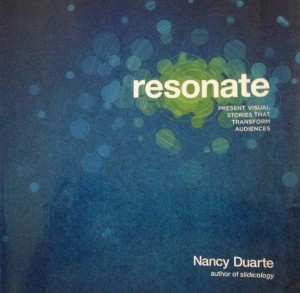 The other day, Aunty was sitting next to Uncle and telling him about one of her very interesting revelations (Aunty gets revelations quite often). In Aunty’s telling of it, Uncle looked at this watch. Aunty got ticked off and stopped in mid sentence. You see, to Aunty, that action meant that he wasn’t really listening, and that he was bored.
The other day, Aunty was sitting next to Uncle and telling him about one of her very interesting revelations (Aunty gets revelations quite often). In Aunty’s telling of it, Uncle looked at this watch. Aunty got ticked off and stopped in mid sentence. You see, to Aunty, that action meant that he wasn’t really listening, and that he was bored.
Uncle, being a nice guy, begged me to continue, but the moment of me wanting to share a revelation with him was lost in the cloud of being insulted (in Aunty’s own mind.)
Who was at fault? To hear Uncle apologize it would seems as if he were. However, after a time of reflection, I do believe the fault was my own – my spoken word bored him, and probably would not engage anyone else who had the misfortune of listening to my dissertations.
Aunty can write easier than speak, especially with spell check and thesaurus tools on the computer. Writing is non invasive. It is the other person’s choice to read, versus the spoken word is invasive. Anyone in earshot will hear the words, whether they want to or not.
So, it is now one of Aunty’s goals to become a better speaker – one that can hold and capture an audience rather than bore or irritate them. That means a whole lot of training, learning, and practicing.
Here is a TED video by Julian Treasure on how to speak so others listen:
One way to practice is to join a local Toastmasters Club – one item on Aunty’s to do list. Aunty’s favorite way to learn is on the internet, searching for ideas and resources. During a search for a great speaking guide, Aunty found a book, “Resonate, present visual stories that transform audiences” by Nancy Duarte. Wow! Just the title had me hooked – Aunty can transform audiences!?
[First off, the author has made it easy for a skim reader like Aunty. She highlights gold nuggets of information for skimmers with bold text, references with green, items of deserved emphasis with orange. The book is filled with outstanding speeches of famous people that she used as examples of excellence. She has a website: www.duarte.com, a goldmine of information.
Turns out, this book is more about presentations in front of an audience – more of a communication goal that is oriented to persuasion. This could work – more of a jump into a bonfire than a flame, but Aunty is game!]
Here is a TED talk that Nancy did in 2010:
Here is Aunty’s book report:
To resonate, you must tune your message to your audience’s minds, needs, wants, rather than expect them to tune into you just because you are speaking. It will take work on your part, with an ebb and flow of content, emotion, and delivery. Make it about your audience. If your ideas stand out, they will be noticed. Stories are the most powerful delivery tool for information. [Einstein once said, if you want your child to be creative, read them fairy tales. If you want them to be more creative, read them more fairy tales.]
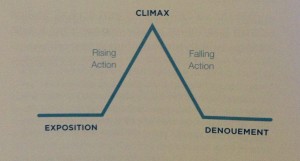 Blending information with stories creates a perfect world for a presentation. Stories have 3 parts: a situation, a complication or conflict, and then a resolution. A great presentation should have a clear beginning, middle, and end. The first plot point in an incident that captures people’s attention with intrigue and interest is called a turning point. In a presentation, this turning point may be an idea, or a solution to a problem, or some kind of conflict or imbalance perceived by your audience that your presentation resolves. You can also create imbalance by juxtaposing what is with what could be.
Blending information with stories creates a perfect world for a presentation. Stories have 3 parts: a situation, a complication or conflict, and then a resolution. A great presentation should have a clear beginning, middle, and end. The first plot point in an incident that captures people’s attention with intrigue and interest is called a turning point. In a presentation, this turning point may be an idea, or a solution to a problem, or some kind of conflict or imbalance perceived by your audience that your presentation resolves. You can also create imbalance by juxtaposing what is with what could be.
The contour or form of a great presentation:
- The Beginning paints a picture of the audience’s reality – this is the what is. The beginning comes before the first turning point. It is historical and the present, often including a problem that the audience has in common. Create a common bond with the audience. That can be short and should not take up more than 10% of the presentation. Then, create a call to adventure, putting forth a memorable big idea that conveys what could be.
- The Middle is the contrast, that first turning point of the call to adventure, and will be made up of various types of contrasts of dilemma and resolution, dilemma and resolution. The middle is continuous back and forth between what is and what could be. This alternating between the two, the present and the possibility pushes and pulls the audience to feel as if events are constantly unfolding, and they will be engaged and interested, wanting to learn how to resolve the imbalance in their lives or achieve what they want. It is very important to know your audience so that you can understand your similar or opposing views. Content that is oppositional to their belief is stimulating. Familiar content is comforting. The call to action gives your audience tasks that they can perform, depending on what type* of person they are – a doer, supplier, influencer, or innovator. All are important, all can be reached if you provide each type with at least one action that they would be comfortable in performing.
- The End of the presentation is concluded with the resolution, a vivid description of the new feeling of bliss that is created when what could be is achieved or reached, and a willingness to be transformed. Let the audience know what the finish line will look like, ending it on a higher plane of enthusiasm with everyone understanding their future rewards.
 It is important that the audience leaves the presentation committed to taking action, that they make a decision to cross the threshold. T.S. Eliot said “What we call the beginning is often the end. And to make an end is to make a beginning. The end is where we start from.”
It is important that the audience leaves the presentation committed to taking action, that they make a decision to cross the threshold. T.S. Eliot said “What we call the beginning is often the end. And to make an end is to make a beginning. The end is where we start from.”
*Four distinct types and profiles of people:
- Doers – instigate activities, the worker bees. They recruit and motivate other doers to complete important activities.
- Suppliers – get resources. These are the ones with financial, human, or material resources. They have the means to get you what you need to move forward.
- Influencers – the ones who can change perceptions of others. These people can sway individuals and groups, mobilizing them to adopt your ideas.
- Innovators – idea generators. These are the ones that think outside the box for new ways to modify and spread your idea. They create strategies, new ways of thinking, products that are new.
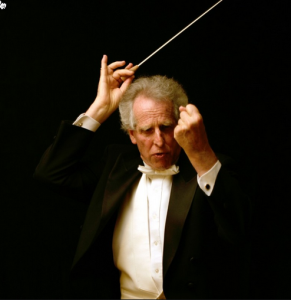 The Sparkline
The Sparkline
The author has a line tool that she calls a sparkline. It consists of the Beginning, and then a series of stories or details about what is followed by what could be with sparkles and star moments sprinkled in. Towards the end of the presentation are contrasting emotion and delivery, and then the call to action that defines what your audience CAN do, followed by the End that paints a vivid picture of the potential reward.
An example of a presentation with all the components of a perfect presentation that leads to the transformation of audiences is Benjamin Zander in his 2008 TED talk. Go to TED.com, search for Benjamin Zander, and enjoy. Chopin anyone?
Get to know your audience
Instead of the old school way of imagining your audience in their pajamas to get over your fear of speaking in front of them, imagine them as a line of individuals waiting to have a face-to-face conversation with you. The audience must be your focus – it is about them, not about you.
Do research on your audience, the more you know who they are, the better you can structure what you say to connect and move them. Figure out what your audience cares about and link it to your idea. Give them something that they didn’t know before, create common ground. Success is having your idea be understood and accepted as a great idea by them.
The Big Idea
Determine what your key message is. This is your goal – it needs to be a complete sentence so it is easily articulated and can be repeated. The message is your Big Idea. It must convey what is at stake (what is compared to what could be), and it must be specific, not a generalization such as “be happy.”
Once you have the Big Idea, identify where your audience is at right now, to where you want to move the audience to. Changing beliefs means changing actions. If they can shift their beliefs to be able to accept your ideas as a viable path, then guide them toward the actions that can get them unstuck from their former beliefs in order to have a reward that is worthwhile for themselves, their sphere of influence, and perhaps even the world.
Every audience will persist in a state of rest unless compelled to change. It is your job to compel them. To do this, you must first assess, and then deliver what they want.
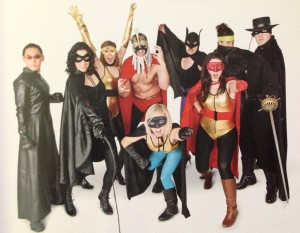 Assess and deliver by meeting the heroes
Assess and deliver by meeting the heroes
Look upon the audience as a room full of heroes. Figure out what they care about and link it to your idea. Be mindful of how you fit in their lives in order to guide them and bolster their confidence in you.
Figure out what your audience cares about and create a link between that and your Big Idea. They need to leave your presentation knowing something that they didn’t know before – the aha moments are powerful, and YOU gave it to them! If you have any common ground with them, use it to make a better connection.
The journey of the Big Idea
First off you must define the destination that you want your audience propelled to. Map it out and be prepared for resistance. When resistance is harnessed properly, it can create forward progress towards acceptance of the one key message you want to communicate – the Big Idea.
The 3 components of a Big Idea:
- A Big Idea must be your point of view, not a generalization.
- A Big Idea must convey a sense of urgency and importance.
- A Big Idea must be a complete sentence that you can articulate.
Use the 2 emotions of pleasure and pain to make your point by raising the likelihood of pain and lowering the likelihood of pleasure if they reject the Big Idea or vice versa, raising the likelihood of pleasure and lowering the likelihood of pain if they accept the Big Idea.
Map out the journey that you want for your audience, moving them from inaction to action, from stuck to unstuck. You are asking them to change. Acknowledge them for it by acknowledging the risk, sacrifice, or their fears. Contemplate all the ways that your audience may resist and address them, at the same time assuring them that the Big Idea is a good one.
The benefits of the Big Idea should appeal to their basic needs such as security, savings, winnings, recognition, improving relationships, achieving goals, or their full potential. Some may refuse or resist the call to action. They need to feel that they are in good capable hands – your hands. They also need to feel that taking action is worth the risk, because of what the reward or payoff will be. [Jeff Olson, says, “the price of neglect is far higher than the price of discipline.]
Create Meaningful Content
Use sticky notes to jot down ideas, facts, stories, projects, possibilities, etc. – anything that supports your presentation. Collect ideas from a multitude of sources, create ideas, and write them down everything that you can.
Have a balance between logical, emotional and ethical appeal.
Think about the issues of opposing points of view for this may give you more ideas for your presentation.
Most great presentations use personal stories. Draw on your past experiences with people in your life, places you have been, or things that can enhance your points. The best stories follow a standard flow – description, problem or conflict, solution. When you can turn your own data base of stored memories and images into stories, you are transforming information that is charged emotionally and makes it more digestible and believable, as well as enjoyable to the audience.
Edit, and edit some more.
Keep in mind the Big Idea. Filter in order to make it clear, not overwhelming your audience with too much information no matter how relevant you might think it is. Slash and delete so you end up with the best stuff in a smaller format. It is easier to digest for your audience.
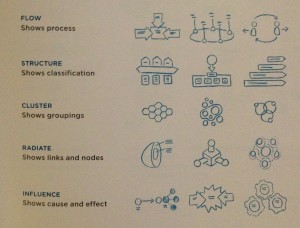 Structure your content
Structure your content
Presentations need to feel organized. Structures help to hold everything together. The most widely used structures are outlines, or a logic tree – giving viewers a snapshot of looking at the whole and not only the parts.
Order your information from the Big Idea or problem to what it is now to what it can become. When you create interaction with emotional responses (i.e. laughter, sympathy) and alternate it with analytical content, your audience will feel and be affected. Avoid reading from the screen – you want human connections, not route readings.
When using slides, present one message or idea per slide. Keep it simple. Use cartoons or pictures that represent words. A solid structured presentation will cause ideas to flow logically and helps the audience see and feel the Big Idea along with you.
Give them something to remember
You want to give them something that is significant, that they will be talking about or thinking about for a long time. Five types of significant moments come from:
- memorable dramatizations – Steve Jobs, when introducing the MacBook Air, pulled it out from a manila envelope
- repeatable sound bites – imitate a famous phrase, a rally call, a crisp message that people will want to repeat to others
- evocative visuals – something that moves the audience
- emotive storytelling – share from your own personal experience or feelings
- shocking statistics – show a graph, chart, comparison that give the viewer a sense of urgency.
Improve
Give a positive first impression.
Speak in the language and manner that will reach your target audience.
Keep it short – a prime example of this was Lincoln’s Gettysburg Address, which lasted only 2 minutes and consisted of just 278 words.
Move away from presenting from slides or use slides just to help your audience recall your message.
Create the right balance of emotion, facts, credibility. Too much or too little of any of these components may leave the audience feeling manipulated.
Practice in front of critics and listen to their feedback.
No matter what the subject matter, practice and practice again to make it perfect.
Changing the World is hard
Creating begins with an idea that can change the world. Change will bring about challenges and resistance. Sometimes you must put your reputation and popularity on the line in order to advance what you believe in. Don’t give up.
Your idea becomes alive when it is adopted by another person, then another, then another until it becomes a groundswell of believers in support. Presentations can be the vehicle to communicate your vision and get support. If your message is done well and moves your audience to action, using the social medium phenomenon of YouTube, Facebook, and others will get your message repeated and possibly viewed by millions.
Be the real you, be transparent. To do this, be honest, be unique, and don’t compromise.
Believe in yourself and your ideas, and others will follow.
Closing
We all have ideas that are potent. If it is a great idea that can change the world for the better, go for it. Communicate your idea in the best way that you can. Gather, prepare, learn from prime examples, write, rewrite, get feedback, and then send your message out to the audience. Change the world!
Aunty’s note: This book took Aunty over 6 months to finish, perhaps because it was just not in Aunty’s sphere of comfort. Aunty’s mind would wonder during chapters. However, if you are in a job or occupation that requires public speaking, this book is an excellent source to help get your point across and into your audience. Next step for Aunty – pick a goal, work on the presentation, and go present it to Uncle. If done well enough, Uncle will say “YES!”
